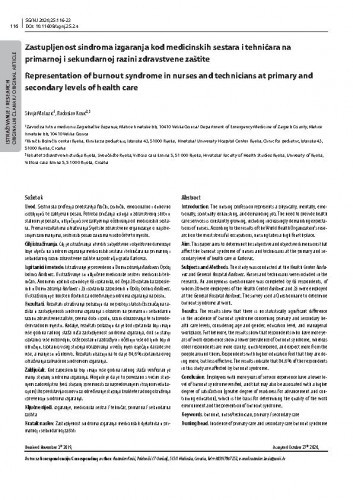Uvod: Sestrinska profesija predstavlja fizički, psihički, emocionalno i duhovno iscrpljujući te zahtjevan posao. Potreba pružanja usluga u zdravstvenoj skrbi u stalnom je porastu, uključujući sve zahtjevnija očekivanja od medicinskih sestara. Prema rezultatima istraživanja Svjetske zdravstvene organizacije o najstresnijim zanimanjima, sestrinski posao zauzima visoko četvrto mjesto. Cilj istraživanja: Cilj je istraživanja utvrditi subjektivne i objektivne dimenzije koje utječu na sindrom izgaranja medicinskih sestara i tehničara na primarnoj i sekundarnoj razini zdravstvene zaštite na području grada Karlovca. Ispitanici i metode: Istraživanje je provedeno u Domu zdravlja Karlovac i Općoj bolnici Karlovac. U istraživanje su uključene medicinske sestre i medicinski tehničari. Anonimni upitnik ispunilo je 65 ispitanika, od čega 30 ispitanika zaposlenih u Domu zdravlja Karlovac i 35 ispitanika zaposlenih u Općoj bolnici Karlovac. U istraživanju je korišten Upitnik za određivanje sindroma izgaranja na poslu. Rezultati: Rezultati istraživanja pokazuju da ne postoji statistički značajna razlika u zastupljenosti sindroma izgaranja s obzirom na primarnu i sekundarnu razinu zdravstvene zaštite, prema dobi i spolu, razini obrazovanja te rukovodećem radnom mjestu. Nadalje, rezultati pokazuju da je kod ispitanika koji imaju više godina radnog staža niža zastupljenost sindroma izgaranja, dok su stariji ispitanici više mrzovoljni, brže postanu razdražljivi i očekuju više od ljudi koji ih okružuju. Ispitanici višeg stupnja obrazovanja u većoj mjeri osjećaju da rade sve više, a manje su učinkoviti. Rezultati ukazuju na to da je 84,6 % ispitanika ovog istraživanja zahvaćeno sindromom izgaranja. Zaključak: Kod zaposlenika koji imaju više godina radnog staža verificiran je manji stupanj sindroma izgaranja. Moguće je da je to povezano s većim stupnjem zadovoljstva (veći stupanj spremnosti za napredovanjem i trajnom edukacijom).; Introduction: The nursing profession represents a physically, mentally, emotionally, spiritually exhausting, and demanding job. The need to provide health care services is constantly growing, including increasingly demanding expectations of nurses. According to the results of the World Health Organization’s research on the most stressful occupations, nursing takes a high fourth place. Aim: This paper aims to determine the subjective and objective dimensions that affect the burnout syndrome of nurses and technicians at the primary and secondary level of health care in Karlovac. Subjects and Methods: The study was conducted at the Health Center Karlovac and General Hospital Karlovac. Nurses and technicians were included in the research. An anonymous questionnaire was completed by 65 respondents, of whom 30 were employees of the Health Center Karlovac and 35 were employed at the General Hospital Karlovac. The survey used a Questionnaire to determine burnout syndrome at work. Results: The results show that there is no statistically significant difference in the incidence of burnout syndrome concerning primary and secondary health care levels, considering age and gender, education level, and managerial workplace. Furthermore, the results show that respondents who have more years of work experience show a lower prevalence of burnout syndrome, whereas older respondents are more cranky, quick-tempered, and expect more from the people around them. Respondents with higher education feel that they are doing more, but less effective. The results indicate that 84.6 % of the respondents in this study are affected by burnout syndrome. Conclusion: Employees with more years of service experience have a lower level of burnout syndrome verified, and that may also be associated with a higher degree of satisfaction (greater degree of readiness for advancement and continuing education), which is the basis for determining the quality of the work environment.
Sažetak

